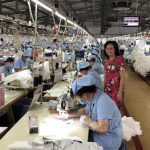The COVID-19 pandemic keeps hurting readymade garment (RMG) exports. Garment shipment, mainly woven products, are yet to fully mend because main export destinations in the EU and the USA are still under strict lockdowns due to the 2nd wave of the COVID-19.
Recent data by the Export Promotion Bureau (EPB) revealed this development. Between July and February, or the current fiscal year’s first 8 months, RMG shipment declined by 3.73 percent year-on-year to $21.03 billion.

During the 8 months, knitwear export earned $11.34 billion, registering a 4.06 percent growth.
However, the woven item shipment declined by 11.49 percent, earning $9.69 billion in the eight months.
Amid this gloom, knitwear shipment has been improving gradually thanks to growing demand from people staying at home for longer periods and shorter lead times. On the other hand, the woven garments sale did not improve as people have cut back on the use of formal wear.
Generally, the sale of woven garments grows concerning the frequency of people going to formal events and offices.
RMG industry insiders say Bangladesh has already become a major knitwear sourcing hub for international fashion brands and retailers courtesy of a short lead time.
Fazlul Hoque, Managing Director of Plummy Fashions said, “Shorter lead time is very important in fast fashion.”

Nearly 90 percent of knitwear raw materials are procured from the local markets. This is because local spinners and weavers have made strong backward linkage support for the garment industry, investing approximately US$10 billion in the primary textile sector.
Whereas, the woven segment is still reliant on the raw material imports, mainly from China, India, Turkey and Pakistan, as the investment in the backward industry did not happen to a comparable extent.
Hoque added, “So, the knitwear export has been increasing from Bangladesh even during the time of the pandemic.”
Rubana Huq, President of the Bangladesh Garment Manufacturers and Exporters Association (BGMEA) said, “The woven sector is clearly in a distressed situation.”
Huq said, “The growth of garment export in February was 5.71 percent in the negative, of which knitwear export registered a 5.78 percent positive growth and woven posted 15.47 percent negative,” further adding that, “Woven garment export growth has dropped for the 19th consecutive month due to a slowdown in demand in the time of lockdown in major markets.”
In the current backdrop of uncertain progress from COVID-19 and the effect on international business, the distressing situation may prevail for more months till demand at the retail end starts responding positively, Huq also said.
BGMEA President stressed that “The price fall issue is another major challenge the industry is facing due to recessed orders. An interim policy measure is required to support the industry to survive till the market shows silver linings.”
Other exporting shipments like leather and leather goods dropped 4.15% to $605.67 million, footwear (other than those of leather) 0.29% to $218.84 million, and raw jute 5.96 percent to $106.36 million in the eight months.
Yet, some sectors’ export earnings went positive. Including, jute and jute goods grew by 23.67 percent to $862.74 million, home textile grew by 38.92 percent to $730.82 million, leather footwear grew by 0.20 percent to $377.34 million.
Overall, the national export earnings declined 3.92% year-on-year to $3.19 billion in February because of a drop in RMG shipment as the lasting COVID-19 pandemic endures to upset the country’s key markets.
(Courtesy: Textile Today)






